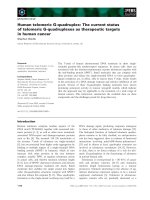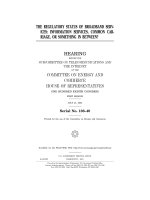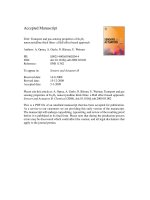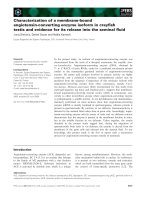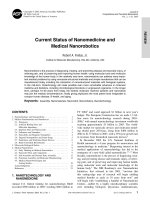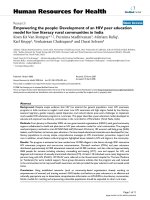Prospect and current status of recycling waste plastics and technology for converting them into oil in China
Bạn đang xem bản rút gọn của tài liệu. Xem và tải ngay bản đầy đủ của tài liệu tại đây (302.47 KB, 9 trang )
Prospect and current status of recycling waste
plastics and technology for converting them
into oil in China
Guang-Hua Zhang a,∗ , Jun-Feng Zhu a , A. Okuwaki b
a
College of Chemistry and Chemical Engineering, Shaanxi University of Science & Technology,
Xianyang 712081, China
b College of Environmental Studies, Tohoku University,
Sendai 980-8579, Japan
Received 13 June 2006; received in revised form 13 November 2006; accepted 15 November 2006
Available online 13 December 2006
Abstract
In the paper, the authors present the current situation of recycling waste plastics and technology of
converting waste plastics into oil in China. The process of pyrolysis and pyrolysis-catalytic upgrade
method has been evaluated in terms of technology and economics. The conditions of a plant, that is to
be constructed for converting waste plastics to oil, such as collecting system, transportation distance of
waste plastics, sorting method and controlling over secondary pollution, are investigated. In addition,
the commercialization and area of research on this technology in China are proposed.
© 2006 Elsevier B.V. All rights reserved.
Keywords: Waste plastics; Consumption of plastics; Converting plastic wastes into oil; Pyrolysis reactor; Catalytic
pyrolysis
Contents
1.
2.
∗
Introduction . . . . . . . . . . . . . . . . . . . . . . . . . . . . . . . . . . . . . . . . . . . . . . . . . . . . . . . . . . . . . . . . . . . . .
Current status of recycling waste plastics . . . . . . . . . . . . . . . . . . . . . . . . . . . . . . . . . . . . . . . . . . .
Corresponding author. Tel.: +86 29 33579787; fax: +86 29 33579787.
E-mail address: (G.-H. Zhang).
0921-3449/$ – see front matter © 2006 Elsevier B.V. All rights reserved.
doi:10.1016/j.resconrec.2006.11.007
232
232
3.
4.
5.
Present technology and industrialization for converting plastic wastes to fuel oils . . . . . . .
3.1. Pyrolysis . . . . . . . . . . . . . . . . . . . . . . . . . . . . . . . . . . . . . . . . . . . . . . . . . . . . . . . . . . . . . . . . . .
3.2. Pyrolysis-catalytic upgrade . . . . . . . . . . . . . . . . . . . . . . . . . . . . . . . . . . . . . . . . . . . . . . . . .
The representative pyrolysis equipment for waste plastics in China . . . . . . . . . . . . . . . . . . . .
The development of technology and industry for converting waste plastics to oil . . . . . . . .
Acknowledgements . . . . . . . . . . . . . . . . . . . . . . . . . . . . . . . . . . . . . . . . . . . . . . . . . . . . . . . . . . . . . .
References . . . . . . . . . . . . . . . . . . . . . . . . . . . . . . . . . . . . . . . . . . . . . . . . . . . . . . . . . . . . . . . . . . . . . .
234
235
236
237
237
238
238
1. Introduction
With a view to the environmental protection and reduction of non-regeneration resource,
recycling technology for converting to oil from plastic wastes has drawn much attention in
China. Some universities and institutes have developed the basis theories and the technology
for industrialization of plastic liquefaction (Huang et al., 2002; X.-X. Li et al., 2002). Many
patents on the converting technology have been adopted. Many pilot plants have been
built up near Beijing, Nanjing, Xi’an, etc. But, some problems have appeared accordingly.
Firstly, there being no effective collecting system and transportation and sorting the collected
waste plastics simply by manual, as a result, the collected plastic wastes cannot satisfy the
continuous production on a large scale. Secondly, the secondary pollution has not been
seriously considered in the process of waste plastics. The environmental considerations
deals with heat energy waste exhaust gas emission, water and dust waste, and the like.
Thirdly, there is no technological standard for the recycling of plastic wastes in China. The
article expatiates upon the current situation of plastic wastes and their recycling technology
for recovering to oil in China.
2. Current status of recycling waste plastics
As one of the most fast developing industries in China, the plastic industry maintains a
growth rate of more than 10% per year. The output of plastics in China reached 26.8 Mt in
2003 (Liao, 2004). Fig. 1 shows the consumption of plastics. In comparison with developed
countries in terms of average consumption, it can be seen that the quantity is less in China.
The average consumption was about 17.5 kg in 2000 (Yang, 2001). Fig. 2 indicates the
usage proportion of plastics in the different fields in 2000 while Fig. 3, the proportion in
sorting the waste plastics (Liao, 2004).
Fig. 4 shows the output of recycling plastic wastes in China (Liao and Liu, 2000). The
reusing plastic wastes have been dramatically increasing from 1996 to 2005. There are many
collection points being distributed in the cities and countries. According to the survey of
the Committee of Economy and Trade of China, the recycling output of the plastic wastes
in China was up to 6 Mt in 2005 (Tan, 2006). Comparing Fig. 1 with Fig. 4, it can be found
that the quantity of plastic wastes in China is still less than that of plastic consumption, and
the proportion of recycling plastic wastes merely reaches one-fifth of the consumption (Ji
et al., 2000).
The post consumer recycled polyvinyl chloride (PVC) is less than other category of
plastic wastes in China. Comparing Fig. 3 with Fig. 5, shows that it is necessary to investigate
how to recover PVC wastes.
Fig. 1. Consumption of plastics in China.
Fig. 2. Usage proportion of plastics by different fields.
The statistic evidence indicates that the recycled plastic wastes account for 0.4–1.5%
of Municipal Solid Waste in China (only 0.14 Mt per year at Beijing). Another source
of plastic wastes is the collected farm films. For instance, the amount of farm film wastes
approximately was 150–225 kg/104 m2 in 2004 at Shaanxi, Heilongjiang, Jilin and Liaoning
provinces of China (Yang, 2001).
Fig. 3. Sorting proportion of plastics in 2003.
Fig. 4. Output of recycled plastic wastes in China.
3. Present technology and industrialization for converting plastic wastes to fuel
oils
The pyrolysis is a principal way to convert plastic wastes to fuel oil. The yield of fuel
oils is under 55% with this method. For this reason, the pyrolysis-catalytic upgrade method
has been employed recently (Liao and Liu, 2000). The production of fuel oils based upon
these methods can reach 55–75%, depending on the composition of plastic wastes. All the
plastic wastes collected are present together in China. Sorting the mixed waste plastics by
Fig. 5. Proportion and sorts of recycling plastic waste in China.
manual is inefficient. Only mixed plastic wastes for being converted to oil can be accepted
in China.
3.1. Pyrolysis
The pyrolysis by direct heating (Fig. 6) was adopted to produce the paraffin and
crude oil from the plastic wastes in the 1990s in China. The small-scaled process is featured by facilitation, convenience and low equipment investment. The system consists of
feed-supply, pyrolysis reactor, fractionating tower, heating and temperature controller and
device for filling the plastics into the pyrolysis reactor. The capacity of this pilot plant is
1000 tonnes/annum. However, the temperature caused by pyrolysis is higher and all the
Fig. 6. Pyrolysis process of generating fuel oil from the waste plastics.
reactive time is longer than the other methods else. The octane number of gasoline gained
is relatively low and the pour point of diesel oil is high. More paraffin is produced in the
process of pyrolysis. Although this process is simple and convenient, the converting rate
and yield is still lower.
The pyrolysis rate and yield should be promoted by a catalyst, like silica–alumina catalyst
or diatomite, etc. (Liu and Chen, 2001). Before the catalyst and plastic waste is mixed within
the pyrolysis reactor, the plastic waste must be cleaned. The total yield of fuel oil is 50–65%,
relying on the composition of plastic waste during pyrolysis. But, one problem is how to
recycle the catalyst, carbon and other residua after pyrolysis. This process is also called the
catalytic pyrolysis.
The other problem for this process is the pyrolysis equipment’s corrosion incurred by
PVC in mixed plastic wastes. Therefore, it is strongly recommended to establish a reasonable
sorting system and apply a efficient technique to eliminate hydrochloric acid.
3.2. Pyrolysis-catalytic upgrade
Since the total yield of fuel oil with pyrolysis is still lower and the quality of oil is not
satisfied as gasoline and diesel oil, the upgrade by catalyst for the crude products gained
with pyrolysis can be used. Having improved the quality of finished oil, this process has
been widely used in many factories (X.-X. Li et al., 2002). Fig. 7 shows the flowchart of
pyrolysis-catalytic upgrade, which has been adopted in factories to treat the mixed plastic
wastes.
The system consists of the knapper, extrusion machine, pyrolysis reactor, catalytic
upgrade reactor, fractionating tower, heating and temperature controller, separator of oil
and water, and oilcan. The factory nearby Beijing used it to produce the fuel oil. The finished oil consists of gasoline (60%) and diesel oil (40%). The total yield reaches as high as
72.5% (Wang et al., 2003).
Fig. 7. Pyrolysis-catalytic upgrades technique of plastic wastes in China.
Fig. 8. Pyrolysis equipment for mixture of plastic waste. (1) Pyrolysis reactor; (2) stirrer; (3) motor; (4) pipe; (5)
heavy oil separator; (6) oil tank.
According to the yield of converting waste plastics to oil in China, the plastic wastes
weighing 1.92 tonnes can produce 1 tonne of fuel oil. A plant with a capacity of 3 tonnes/day
will need 1728 tonnes of plastic wastes annually. Supposing the average content of plastic
wastes is that the Municipal Solid Wastes account for about 0.5% for cities and 0.3% for
countryside (Ji et al., 2000), the economic transportation distance will be within 200 km or
so. As the economic support from local government is short, and the whole process from
collecting, transporting, sorting to converting must be in accordance with marketing rule,
the plant has to face towards a big risk in converting plastic wastes to fuel oil.
4. The representative pyrolysis equipment for waste plastics in China
Comparing the fixed bed catalytic reactor with fluidized bed reactor (Kiran et al., 2000;
Bruce et al., 1999; W.-H. Li et al., 2002), it can be seen that the structure of pyrolysis reactor
is very simple. Fig. 8 presents the representative pyrolysis device for waste plastics, reported
by a Chinese patent (Qian, 2002). The device is made of the carbon steel or stainless steel.
As a contemporary reactor, it is impossible to be developed into any larger scale equipment
to rationalize the operations, inclusive of automatic control and more same reactor units.
5. The development of technology and industry for converting waste plastics to oil
The law and regulation for recycling plastic waste has been enacted and the efficient collecting system has formed with the economic development of China. There are many parks
and residential areas in China placing collection points for waste plastics. The recycling
of plastic wastes is becoming a new attractive field in that it can save resource and protect
the environment. The National Committee of Recycling and Utilization of Plastic Wastes
was founded as early as 1992 in China. Its duty is to guide the recycling and utilization of
waste plastics. The current status of technology for converting plastic wastes to oil can adapt
itself to the actuality of China. The plants with a capacity of 1000 tonnes/annum have been
running nearby many cities in China (Tan, 2006), but, there are many subsequent problems
to be solved in the near future. In China, the further tasks are to constitute the standards for
process and products of post-consumer recycled plastics and to adopt the more advanced
pyrolysis technologies for waste plastics, such as fixed bed catalytic reactor or fluidized
bed reactor, referring to the experiences of developed countries, like Germany and Japan,
especially (Kiran et al., 2000; Miller et al., 2005; Scott et al., 1999; Chen, 2005; Shi and
Chuai, 2006). In addition, the type of pyrolysis reactor must be designed to suit the mixed
waste plastics and small-scaled and middle-scaled production. The scientist should pay
more attention to exploring the recycling and pyrolysis of waste PVC and the optimization
of operational conditions of pyrolysis for waste plastics (Shah et al., 1999; Tan, 2006; Ali
and Siddiqui, 2005; Jale et al., 2001; Miranda et al., 2001). A novel and more efficient
catalyst ought to be studied for the process of pyrolysis and pyrolysis-catalytic upgrade
technique, and the mechanism of pyrolysis should also be explored (Park et al., 1999).
From the view of environmental protection as well as the economics, a novel and reasonable technology is needed. This is the responsibility of the governments and the producers.
The reuse of waste plastics, one of the avenues to tackle the resource shortness, will be able
to play a vital role in the near future in China.
Acknowledgements
The project is sponsored by Institute of Environmental Protection and Economy on
Energy, Xianyang, China. We are also very grateful to professors Ma Hong-rui and Liu
Bao-jian of Shaanxi University of Science & Technology for their dedications.
References
Ali MF, Siddiqui MN. Thermal and catalytic decomposition behavior of PVC mixed plastic waste with petroleum
residue. J Anal Appl Pyrolysis 2005;74(1–2):282–9.
Bruce JM, Leo AB, Franco B. J Anal Appl Pyrol 1999;51:157–66.
Chen F-Z. Reclaiming technology of Japanese used plastics. World Plastic 2005;23(3):50–62.
Huang Y, Yan H-X, Zhang Q-Y. Liquid fuel manufactured from waste plastics cracking. Plastics 2002;31(4):36–40
(in Chinese).
Jale Y, Azhar U ddin M, Kazuo I, et al. Polym Degrad Stab 2001;73:335–46.
Ji X, Qian J-L, Wang J-Q, et al. Prospect and current situation of technologies for converting plastic waste to oil
in China. Environ Protect Chem Ind 2000;20(6):18–22 (in Chinese).
Kiran N, Ekinci E, Snape CE. Recycling of plastic wastes via pyrolysis. Resour Conserv Recycl 2000;29(4):273–83.
Li W-H, Li Y-H, Qin Q, et al. Study on industrial apparatus to produce gasoline and diesel by catalytic cracking
for waste plastics. Appl Chem Ind 2002;1(31):44–6 (in Chinese).
Li X-X, Shi Y-F, Yu H-R. Preparation of fuel oil from plastic waste by catalytic cracking. Environ Protect Chem
Ind 2002;22(2):90–4 (in Chinese).
Liao Z-P, Liu Y-J. Status of plastics processing industry and suggestions on its development. Modern Chem Ind
2000;20(7):5–8 (in Chinese).
Liao Z-P. Situation of china plastics industry in 2003. China Plastics 2004;18(6):1–7 (in Chinese).
Liu G-Z, Chen E-T. Catalytic cracking of scrap plastics into gasoline and diesel oil by a pilot experiment unit.
Environ Sci Technol 2001;98(6):9–10 (in Chinese).
Miller SJ, Shah N, Huffman GP. Conversion of waste plastic to lubricating base oil. Energy Fuels
2005;19(4):1580–6.
Miranda R, Pakdel H, Roy C, et al. Polym Degrad Stab 2001;73:47–67.
Park DW, Hwang EY, Kim JR, et al. Polym Degrad Stab 1999;65:193–8.
Qian C-L. A novel equipment of pyrolysis for converting plastic waste to oil, CN 2540412; 2002.
Scott DS, Majerski P, Piskorz J, Radlein D, Barnickel M. Production of liquid fuels from waste plastics. Can J
Chem Eng 1999;77(5):1021–7.
Shah N, Rockwell J, Huffman GP. Conversion of waste plastic to oil: direct liquefaction versus pyrolysis and
hydro-processing. Energy Fuels 1999;13(4):832–8.
Shi B-Y, Chuai C-Z. Research development of technology using waste plastics and cracked catalyst producing
fuel oil. Plastic Sci Technol 2006;34(3):61–2 (in Chinese).
Yang H-D. Retrospect and prospect, development situation and trend of China plastics industry. China Plastics
2001;15(6):1–9 (in Chinese).
Tan Y-W. Current situation in the Chinese plastics recycling market. Chem Fibers Int 2006;56(3):182–5.
Wang L, Luo G-H, Li Q. Progress of waste plastics pyrolysis. Chem Ind Eng Progr 2003;22(2):130–4 (in Chinese).


